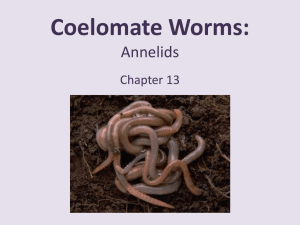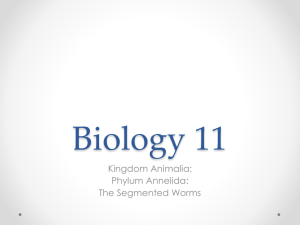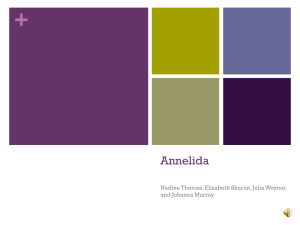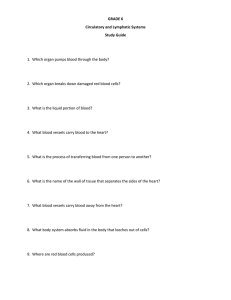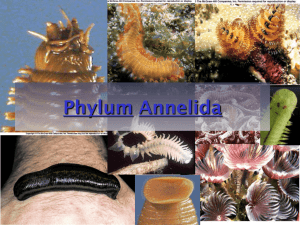Phylum Annelida & Circulatory Systems 9.1
advertisement
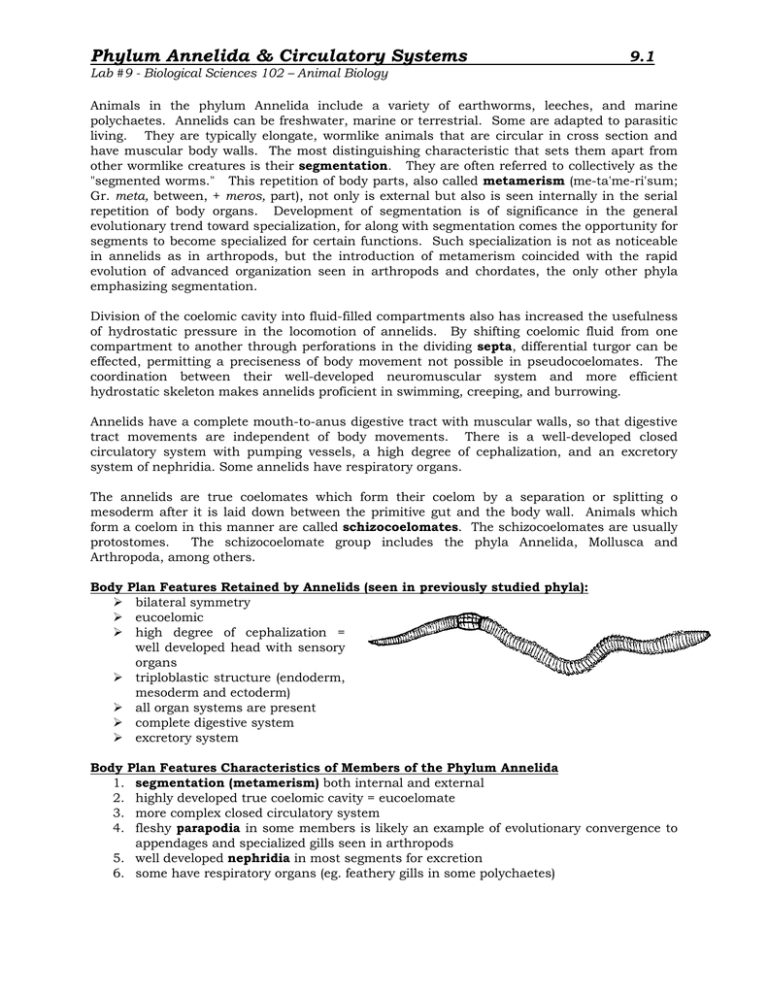
Phylum Annelida & Circulatory Systems 9.1 Lab #9 - Biological Sciences 102 – Animal Biology Animals in the phylum Annelida include a variety of earthworms, leeches, and marine polychaetes. Annelids can be freshwater, marine or terrestrial. Some are adapted to parasitic living. They are typically elongate, wormlike animals that are circular in cross section and have muscular body walls. The most distinguishing characteristic that sets them apart from other wormlike creatures is their segmentation. They are often referred to collectively as the "segmented worms." This repetition of body parts, also called metamerism (me-ta'me-ri'sum; Gr. meta, between, + meros, part), not only is external but also is seen internally in the serial repetition of body organs. Development of segmentation is of significance in the general evolutionary trend toward specialization, for along with segmentation comes the opportunity for segments to become specialized for certain functions. Such specialization is not as noticeable in annelids as in arthropods, but the introduction of metamerism coincided with the rapid evolution of advanced organization seen in arthropods and chordates, the only other phyla emphasizing segmentation. Division of the coelomic cavity into fluid-filled compartments also has increased the usefulness of hydrostatic pressure in the locomotion of annelids. By shifting coelomic fluid from one compartment to another through perforations in the dividing septa, differential turgor can be effected, permitting a preciseness of body movement not possible in pseudocoelomates. The coordination between their well-developed neuromuscular system and more efficient hydrostatic skeleton makes annelids proficient in swimming, creeping, and burrowing. Annelids have a complete mouth-to-anus digestive tract with muscular walls, so that digestive tract movements are independent of body movements. There is a well-developed closed circulatory system with pumping vessels, a high degree of cephalization, and an excretory system of nephridia. Some annelids have respiratory organs. The annelids are true coelomates which form their coelom by a separation or splitting o mesoderm after it is laid down between the primitive gut and the body wall. Animals which form a coelom in this manner are called schizocoelomates. The schizocoelomates are usually protostomes. The schizocoelomate group includes the phyla Annelida, Mollusca and Arthropoda, among others. Body ¾ ¾ ¾ ¾ ¾ ¾ ¾ Plan Features Retained by Annelids (seen in previously studied phyla): bilateral symmetry eucoelomic high degree of cephalization = well developed head with sensory organs triploblastic structure (endoderm, mesoderm and ectoderm) all organ systems are present complete digestive system excretory system Body Plan Features Characteristics of Members of the Phylum Annelida 1. segmentation (metamerism) both internal and external 2. highly developed true coelomic cavity = eucoelomate 3. more complex closed circulatory system 4. fleshy parapodia in some members is likely an example of evolutionary convergence to appendages and specialized gills seen in arthropods 5. well developed nephridia in most segments for excretion 6. some have respiratory organs (eg. feathery gills in some polychaetes) Phylum Annelida & Circulatory Systems 9.2 Lab #9 - Biological Sciences 102 – Animal Biology Phylum Annelida Classification Class Polychaeta (pol'e-ke'ta) (Gr. polys, many, + chaiti?, long hair). Segmented inside and out; parapodia with many setae; distinct head with eyes, palps, and tentacles; no clitellum; separate sexes, trochophore larva usually present; mostly marine. Examples: Nereis, Chaetopterus. Class Clitellata, Subclass Oligochaeta (ol'i-go-ke'ta) (Gr. oligos, few, + chaiti'!, long hair). Body segmented inside and out; number of segments variable; clitellum present; few setae; no parapodia, head poorly developed; coelom spacious and usually divided by intersegmental septa; direct development; chiefly terrestrial and freshwater. Examples: Lumbricus, Tubifex. Class Clitellata, Subclass Hirudinae (hir'u-din' ea) (1. hirudo, leech, + ea, characterized by). Segments 33 or 34 in number, with many annuli; clitellum present; anterior and posterior suckers; setae absent (except Acanthobdella); parapodia absent; coelom closely packed with connective tissue and muscle; terrestrial, freshwater, and marine. Examples: Hirudo, Placobdella. ADAPTATIONS OF AND USES FOR LEECHES The medicinal leech is amphibious, needing both land and water, and resides exclusively in fresh water. A typical habitat for H. medicinalis would be a small pond with a muddy bottom edged with reeds and in which frogs are at least seasonally abundant. The medicinal leech has a cylindrical, dorsoventrally flattened body divided into thirty-three or thirty-four segments. The dorsal side is dark brown to black, bearing six longitudinal, reddish or brown stripes, and the ventral surface is speckled. All members bear a posterior and anterior disk-shaped sucker. The anterior sucker surrounds the oral opening where the teeth for incison are located. In addition, the medicinal leech has five pairs of eyes located on its front end. H. medicinalis has several pairs of testes and one pair of ovaries as well as a thickening of the body ring, known as a clitellum, which is visible during the breeding season. H. medicinalis breeds once during an annual season that spans June through August. It also remains fertile over a period of years,unlike most other leech species. The act of copulation takes place on land, where one leech attaches ventrally to one another by means of a mucus secretion. All leeches are hermaphroditic and fertilization is internal. Sperm is injected into the vagina by an extendable copulatory organ. A cocoon is formed around the clitellum and slips Phylum Annelida & Circulatory Systems 9.3 Lab #9 - Biological Sciences 102 – Animal Biology off the anterior section of the leech. The whole egg sac is laid in damp soil usually just above the shoreline. After about 14 days, the eggs hatch as fully formed miniature adults. Motility is achieved both in land and water. Hirudo medicinalis moves in water by contraction of the longitudinal muscles of the body in a wave-like motion which propels it forward in the water. Movement on land is accomplished by means of "looping", a movement similar to that of inch worms. They attach themselves to the substrate alternately by their anterior and posterior suckers. Hirudo medicinalis is parasitic and the adults feed on the blood of mammals. It attaches to the host by means of its two suckers and bites through the skin of its victim. Simultaneously, the leech injects an anaesthetic so that its presence is not detected, and an anticoagulant in order for the incision to remain open during the meal. It has three jaws, which work back and forth during the feeding process, which ususally lasts about 20 to 40 minutes and leaves a tripartite star-shaped scar on the host. After a full meal of 10ml to 15 ml of blood, the medicinal leech may increase 8 to 11 times its initial body size. Leeches only feed about once every six months, this is about how long the blood meal takes to be fully digested. Certain bacteria keep the blood from decaying during the long digestion period. H. medicinalis may even go longer than six months without food by digesting its own tissues. The medicinal leech, as its name suggests, has historically been used for medicinal purposes, mainly to remove "bad blood" from the diseased. Around 1850 this practice fell into disrepute, but H. medicinalis is again becoming of value in medicinal practices. Today this species is used to relieve pressure and restore circulation in tissue grafts where blood accumulation is likely such as severed fingers and ears. The anticoagulant of leeches is also a fertile ground of research for surgeries in which an incision must be kept open. In addition, leech saliva is found to contain powerful antibiotics and anaesthetics which no doubt will prove useful in future medicinal practice. The anticoagulant produced by Hirudo is a potent inhibitor of thrombin – part of the clotting cascade in vertebrates. From the British Journal of Plastic Surgery – 2004 Hirudo Medicinalis and the Plastic Surgeon. Whitaker IS, Izadi D, Oliver DW, Monteath G, Butler PE. “Medicinal leech therapy is an ancient craft that dates back to ancient Egypt and the beginnings of civilisation. The popularity of Hirudo Medicinalis has varied throughout history, reaching such a peak in Europe in the early 19th century that supplies were exhausted. During the latter half of the 19th century, their use fell out of favour, as they did not fit in with the emerging concepts of modern medicine. Leeches have enjoyed a renaissance in the world of reconstructive microsurgery during recent years, and their first reported use in alleviating venous engorgement following flap surgery was reported in this journal [M Derganc, F Zdravic, Venous congestion of flaps treated by application of leeches, Br J Plast Surg 13 (1960) 187]. Contemporary plastic and reconstructive surgeons in units throughout the United Kingdom and Ireland continue to use leeches to aid salvage of failing flaps. We carried out a survey of all 62 plastic surgery units in the United Kingdom and the Republic of Ireland to assess the current extent of use, and to investigate current practice. We have shown that the majority of plastic surgery units in the UK and Ireland use leeches post-operatively and that the average number of patients requiring leech therapy was 10 cases per unit per year. Almost all units use antibiotic prophylaxis, but the type of antibiotic and combination used is variable. We outline current practice and suggest a protocol for the use of leeches. Whilst the use of leeches is widespread, the plastic surgery community has progressed little in defining indications for their use or in achieving an accepted protocol for their application in units throughout the UK and Ireland”. Phylum Annelida & Circulatory Systems 9.4 Lab #9 - Biological Sciences 102 – Animal Biology ¾ Circulatory Systems Open circulatory system = a circulatory system, characteristic of some invertebrates, (eg, some molluscs and arthropods), in which blood flows through an interconnected system of open sinuses rather than blood vessels. The tissues and cells are directly bathed by the blood for gaseous exchange and nutrient uptake. The circulatory fluid is called the hemolymph or endolymph. Closed circulatory system = a circulatory system in which blood flows through blood vessels at all times. Blood flows from arteries to capillaries and through veins, but the tissues surrounding the vessels are not directly bathed by blood. Some invertebrates and all vertebrates have closed circulatory systems Heart = a pumping organ or series of modified arteries (eg. dorsal hearts) that have an innate ability to contract due to their unstable resting membrane potentials. This organ beats on its own with a regular rhythm without direct stimulation by the nervous system. However, the nervous system may modulate the rhythmic contractions of this organ. Arteries = thicker walls, smaller cross section, often pleated appearance. Arteries carry blood away from the heart. Veins = thinner walls, often collapse and look flattened in dissected specimens. Veins carry blood to the heart. Arterioles = considerably smaller than arteries and thus provide the greatest resistance to blood flow. In animals that have a closed circulatory system, arterioles carry blood from arteries to capillaries. Capillaries = vessels made of a single layer of endothelial cells surrounded by a basement membrane. These are the only vessels whose walls are thin enough to allow for exchange of gases, nutrients, and waste products. These substances move down their concentration gradients (oxygen is higher in the blood than the tissues so it moves from the blood to the tissues; carbon dioxide levels are higher in the tissues and so it moves into the blood Veins = relatively thin walls, smaller muscle layer relative to arteries, more distensible than arteries. Veins carry blood to the heart. Venous Valves = in some animals, one way flap valves that prevent the backflow of blood caused by the force of gravity. These valves are needed as the venous blood pressure is considerably lower than the arterial blood pressure. Blood is forced through the valves by skeletal muscle action. Veins run between skeletal muscle fibers and as the fibers contract, blood is forced through the veins in vertebrates and some invertebrates. ¾ DRAW THE DIAGRAM ON THE BOARD OF EARTHWORM CIRCULATION BELOW: Phylum Annelida & Circulatory Systems 9.5 Lab #9 - Biological Sciences 102 – Animal Biology LAB PROCEDURE LAB SCORE: NAME: Refer to the chapter on annelids in the Hickman text for illustrations, diagrams and additional information about segmented worms. Observation of Living Specimens Class Clitellata Subclass Oligochaeta (terrestrial and freshwater segmented worms) ¾ ¾ Observe the specimens and/or diagrams of the earthworm, Lumbricus terrestris. Record the descriptive information requested at the end of the lab for this species. Class Clitellata Subclass Hirudinea (leeches) ¾ ¾ Observe the specimens and/or diagrams of the mixed leeches in the genus Hirudo. Record the descriptive information requested at the end of the lab for this species. ¾ Observe the end of lab class demonstration by your instructor of the locomotion and feeding activity of the medicinal leech, Hirudo medicinalis. Class Polychaeta (marine segmented worms) ¾ ¾ Observe the specimens and/or diagrams of the various available polychaetes. Record the descriptive information requested at the end of the lab for these species. ¾ The polychaete subclasses Errantia and Sedenteria are somewhat artificial groupings and in this lab are solely used to categorize species based on their degree of mobility and feeding strategies rather than to indicate any degree of common evolutionary descent. Errantia and Sedenteria are no longer valid subclasses. ¾ Microscopy Procedures Class Polychaeta (marine segmented worms) ¾ ¾ ¾ Read and review the features of the clamworm Nereis in your lab manual. Observe a microscope slide of a cross section of the polychaete Nereis and identify the basic structures from your lab manual. Observe a microscope slide of a Nereis parapodium and identify the basic structures from your lab manual. Class Clitellata Subclass Oligochaeta (terrestrial and freshwater segmented worms) ¾ ¾ ¾ ¾ Read and review the features of the earthworm Lumbricus in your lab manual. Observe a microscope slide of a cross section of the intestinal region of the oligochaete Lumbricus and identify the basic structures from your lab manual. Observe a microscope slide of a cross section of the nephridia/nephridiopore of Lumbricus and identify the basic structures from your lab manual. Phylum Annelida & Circulatory Systems 9.6 Lab #9 - Biological Sciences 102 – Animal Biology ¾ Earthworm Dissection Procedure (see the supplemental lab manual) Class Clitellata Subclass Oligochaeta (terrestrial and freshwater segmented worms) ¾ ¾ ¾ Review all of exercise 12B in the lab manual. As per your instructor’s directions, obtain a live Lumbricus terrestris (earthworm) Follow the directions for behavior observation, external structure identification and internal structure dissection provide by both the lab manual and by your instructor. ¾ Be sure to perform the behavioral observations BEFORE euthanizing your earthworm. ¾ DRAW AND CLEARLY LABEL A DIAGRAM OF YOUR EARTHWORM DISSECTION BELOW. Phylum Annelida & Circulatory Systems 9.7 Lab #9 - Biological Sciences 102 – Animal Biology Living Specimens Data Class Clitellata Subclass Oligochaeta (terrestrial and freshwater segmented worms) Scientific name: Lumbricus terrestris Common name: Dimensions of this specimen: Notes & observations to help you remember and distinguish this group/species: Class Clitellata Subclass Hirudinea (leeches) Scientific name: Hirudo medicinalis Common name: Dimensions of this specimen: Notes & observations to help you remember and distinguish this group/species: Phylum Annelida & Circulatory Systems 9.8 Lab #9 - Biological Sciences 102 – Animal Biology Note that the old, historically used Subclasses of Errantia and Sedenteria are no longer valid taxonomic categories, we use them for simplification of study only. Class Polychaeta “Errantia” (errant, free-living segmented worms) Scientific name: Common name: Color of this specimen: Notes & observations to help you remember and distinguish this group/species: Class Polychaeta “Errantia” (errant, free-living segmented worms) Scientific name: Common name: Color of this specimen: Notes & observations to help you remember and distinguish this group/species: Class Polychaeta “Errantia” (errant, free-living segmented worms) Scientific name: Common name: Color of this specimen: Notes & observations to help you remember and distinguish this group/species: Phylum Annelida & Circulatory Systems Lab #9 - Biological Sciences 102 – Animal Biology Class Polychaeta “Sedentaria” (sedentary, segmented tube worms) Scientific name: Common name: Color of this specimen: Notes & observations to help you remember and distinguish this group/species: Class Polychaeta “Sedentaria” (sedentary, segmented tube worms) Scientific name: Common name: Color of this specimen: Notes & observations to help you remember and distinguish this group/species: Class Polychaeta “Sedentaria” (sedentary, segmented tube worms) Scientific name: Common name: Color of this specimen: Notes & observations to help you remember and distinguish this group/species: 9.9 Phylum Annelida & Circulatory Systems 9.10 Lab #9 - Biological Sciences 102 – Animal Biology HOMEWORK – use the internet to help you answer these questions: ¾ What is a sabellid worm? ¾ Briefly describe and/or draw a flowchart diagram to show the lifecycle of a typical leech. ¾ Briefly describe how the parchment tubeworm Chaetopterus feeds and what it typically eats. ¾ What is the feeding strategy of the polychaete worm Nereis and what does it typically eat? Phylum Annelida & Circulatory Systems Lab #9 - Biological Sciences 102 – Animal Biology LABORATORY NOTES: 9.11 Phylum Annelida & Circulatory Systems Lab #9 - Biological Sciences 102 – Animal Biology LABORATORY NOTES: Chaetopoda by Haeckel 9.12
